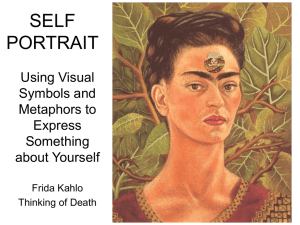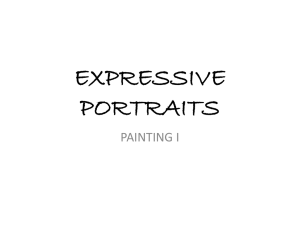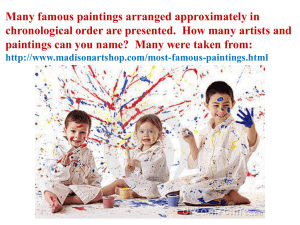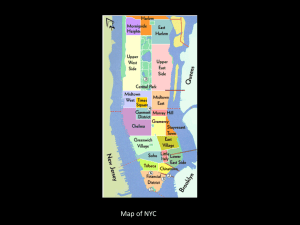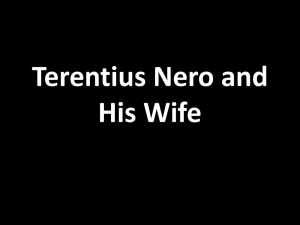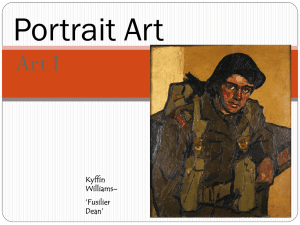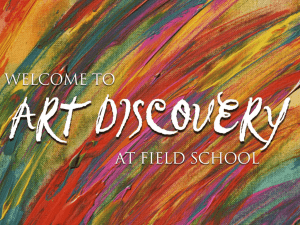Self Portrait
advertisement
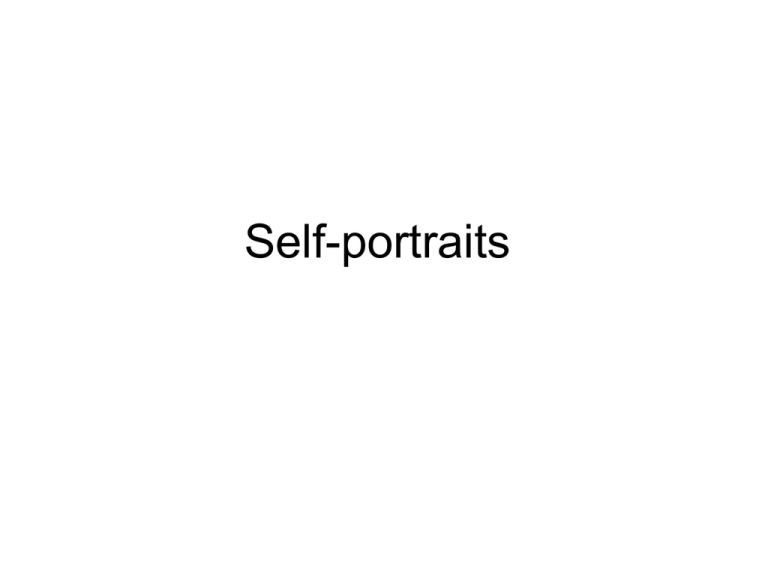
Self-portraits Vase of Lilacs, Roses, and Tulips Gustave Courbet French, 1819-1877 Oil on canvas Both of these paintings were done by the same person. I don’t know about you, but I’m much more interested in the self portrait. Why do you think that is? What do you want to know about the artist? Throughout time and by all reflective individual we as human ask ourselves… • • • • • Who am I? What are the distinctive things that make me "me"? How do I want people to see me? How can I express my many different sides? How can I reinvent myself for various purposes or times in my life? • How am I changing from day to day or year to year? • Who do I want to become? Artists… Since the fifteenth century and the advent of the mirror have modeled for themselves in their own works of art. Whether it is an in-depth exploration of the artist’s own psyche or simply because as a model, the artist is clearly the cheapest and most available. Whatever the reason, nearly every artist, in every medium from painters to sculptors have attempted this exploration of self. Jean Fouquet (French, c. 1420 -c. 1477-1481), SelfPortrait, c. 1450 enamel on copper The artist holds a medallion inscribed in Latin around the rim: "The maiden Sofonisba Anguissola, depicted by her own hand, from a mirror, at Cremona." Inside the circle is a cryptogram whose entwined letters are included in the name of Anguissola's father, Amilcare. The meaning and original purpose of this enigmatic portrait remain a mystery Sofonisba Anguissola, Self-Portrait, c. 1555, oil on parchment, 3 1/4 x 2 1/2 inches (8.2 x 6.3 cm), Self Portrait as. . . Artist as. . . Character Artemisia Gentileschi, Self-Portrait as a Lute Player, ca. 1615–17 Artemisia Gentileschi, Self-Portrait as the Allegory of Painting, ca. 1638 Judith Leyster Self Portrait 1633 Diego Velázquez (Diego Rodríguez de Silva y Velázquez) (Spanish, 15991660), The Family of Philip IV, or "The Maids of Honor (Las Meninas)", c. 1656, oil on canvas, (318 x 276 cm), Prado Museum, Madrid. • Balthus (born Balthasar Klossowski de Rola) (French, 1908-2001), The Painter and His Model, 1980-1981 • Lee Krasner (American, 1908-1984), SelfPortrait, c. 1930, oil on linen Detail from "The Last Judgement" by Michelangelo, Sistine Chapel, Vatican Museum, Vatican City, Rome, Italy. Michelangelo’s self-portrait as Nicodemus in the Duomo Pietá, Florence • James Montgomery Flagg (American, 18771960), I Want You for U.S. Army, 1917, • Flagg's version of Uncle Sam is a self-portrait. Self Portrait and. . . Aging Albrecht Durer, Self-portrait age 22, 1493 Albrecht Durer, Self-portrait age 26, 1498 Albrecht Durer, Self-portrait age 28,1500 Rembrandt Harmensz. van Rijn (Dutch, 16061669) Self-Portrait at TwentyTwo , 1628, oil on panel, Self portrait, 1661 Self portrait, 1657 Edgar Degas Self Portrait 1907 Pablo Picasso, Self Portrait 1896 Self Portrait with Cloak 1901 Self Portrait 1907 Camille Pissarro Self Portrait, 1873 Camille Pissarro (French, 1830-1903), Self Portrait, 1903, oil on canvas, 41.0 x 33.3 cm Color creates mood and tone Jean-Baptiste Siméon Chardin (French, 1699-1779), SelfPortrait in Spectacles, 1771, pastel, on bluegray paper over canvas Self Portrait and. . . Expression Léopold Boilly (French, 1761-1845), Grimacing Man (Self-Portrait), c. 1822-23, conté crayons on paper Self Portrait and. . . Expressionism • Egon Schiele was an Austrian Expressionist painter having studied at the Vienna Academy of Fine Arts and meeting artist Gustav Klimt, Schiele went on to produce expressive work. Egon died from Spanish influenza in 1918, aged 28. •Self-Portrait with Lowered Head, 1912 by Egon Schiele Egon Schiele, Self-Portrait, 1910 Self Portrait and. . . Adornment (which can) – tell a story – show a time period – represent personal preferences – show a specific activity or career Paul Cezanne Self Portrait In A White Cap Self Portrait with Beret Mary Cassatt. Self-Portrait. c.1880Watercolor on paper Self Portrait with Bandaged Ear Vincent Van Gogh Vincent van Gogh (Dutch, 1853-1890), SelfPortrait with a Straw Hat Self-portrait with bandaged ear and pipe, 1889 Self-portrait without Beard, 1889 Self Portrait with Bandaged Ear Vincent Van Gogh •Vincent van Gogh (Dutch, 1853-1890), Self-Portrait with a Straw Hat • Stanislaw Ignacy (Witkacy) Witkiewicz (Polish, 18851939), Self-Portrait, 1927,pastel on paper Witkiewicz, self-portrait in pastel, 1938 • Montien Boonma (Thai, 1953-2000), SelfPortrait: A Man Who Admires Thai Art, 1982, photograph altered with decorative patterns drawn in colored ink. Susan Coffey Self Portrait and. . . Color Paul Gauguin – Self-portrait with Halo, 1889 Paul Gauguin, Self-Portrait, c. 18931894, oil on canvas Pierre Bonnard. Self-Portrait. c. 1889. Tempera on canvas. •Pierre Bonnard (French, 1867-1947), Self-Portrait in the Bathroom Mirror, 1939-1945, oil on canvas André Derain (French, 18801954), Portrait of the Artist, about 1912-1914, oil on canvas •Paula Modersohn-Becker (German, 1876-1907), SelfPortrait, Half-Figure with Amber Necklace II (Selbstbildnis als Halbakt mit Bernsteinkette II) • Xenia Hausner, All of Me, mixed media, 2008. Courtesy: Forum Gallery. Catherine Kehoe The face I deserve, 2002 oil on panel 8"x8" SP in orange 2010 oil on board 6"x4" Self Portrait and. . . Symbolism Frida Kahlo July 6, 1907 – July 13, 1954 Frida Kahlo Symbolism: Irony of Luck: Hummingbirds are a traditional Mexican symbol of Luck Christianity: Crown of thorns as necklace Rebirth/Resurrection: Dragonflies and Butterflies Political opinion of feminism: Exaggerated mustache and Monobrow Self Portrait with Thorn Necklace and Hummingbird, 1940 Self Portrait and. . . Photorealism Chuck Close, Self-Portrait , 1997 oil on canvas 102 x 84” Chuck Close, Self-Portrait , 2004-2005 oil on canvas 102 x 86” Self Portrait and. . . Point of View Jenny Saville Closed Contact Self Portrait Self Portrait and. . . Texture Lucian Freud Lucian Freud Reflection Self-portrait 1985 Oil on Canvas Lucian Freud’s Self Portrait: Reflection (2002) Self Portrait and. . . The Mentor Artist Kehinde Wiley Jacques-Louis David’s Napoleon Self portrait after Jacques-Louis David’s Napoleon. Elizabeth Peyton Elizabeth Peyton, Georgia (After Stieglitz 1918), 2006, monotype on handmade paper, 30 x 22 inches Alfred Stieglitz (January 1, 1864 – July 13, 1946) was an American photographer and modern art promoter who was instrumental over his fifty-year career in making photography an accepted art form Ice T, Kehinde Wiley Sir Luke Fildes [English Painter, 1843-1927] Portrait of King Edward VII Dutch portrait Rap Artist, Charles Hamilton Triple Portrait of Charles I , 2007 Oil and enamel on three canvases Kehinde Wiley Cindy Sherman • Since the mid-1970s, Sherman has photographed herself, not to make selfportraits, but to picture herself posing as characters she has invented. She has made many series of such photos, in which she has transformed herself through the use of cosmetics, costumes, hairstyles, body language and facial expressions. Cindy Sherman, Self-portrait Caravaggio, Self-Portrait as Sick Bacchus, 1593 Cindy Sherman Untitled #228 1990 Sandro Botticelli Judith Leaving the Tent of Holofernes, 1495-1500 Steve Breerwood Zoning After Millet 2006 Oil on Canvas 52 x 67.5 inches Jean-Francois Millet (1814-1875) The Gleaners 1857 Oil on Canvas 110 x 84 cm Websites to Check Out for Research: • National Portrait Gallery – http://www.npg.si.edu/ • Artlex on Self Portraits – http://www.artlex.com/ArtLex/s/selfportrait.html • Contemporary Artists – http://the-artists.org/ From left to right Leonardo da Vinci, Portrait of Cecilia Gallarani (Lady with an Ermine) 1489 James C. Christensen, Lady with Poppies 1990 Zuzana Stanková, Dama, 2001 How does Leonardo influence the following two artists? Research: 1. Artist’s Biography. 2. Who/what are they influenced by? What is their work about? 3. How do they work? What materials do they use? What size do they work in? How do they get their ideas? 4. Why have you chosen this artist? What are some ways you can incorporate their work into your selfportrait? 5. Create a minimum of two sketches of this artist’s work in color. Prints of their work will also be useful. Thumbnails Minimum of 4 thumbnails (2x3inches) -Include accurate depiction of the self from the mirror. -Value and Color show form and create mood or idea. -Evidence of influence from mentor artists in style and subject matter. -Include a written explanation (notes/shorthand is fine) for the following: 1. What is this self portrait exploring about you? (refer back to the series of questions you answered about yourself) 2. How is it influenced by your mentor(s)? Sketch one of these portraits to draw. What are the similarities and differences between these portraits? Max Ernst Francis Bacon Gala Eluard 3 studies of a self portrait Alphonse Mucha Joan of Arc Underpainting: It's chief value is in creating luminescence in the painting, since light reflects through it from the back of the canvas; and also for uniting color values in the overall painting by adding a subjective dominant color key. J.W. Waterhouse Tonal underpainting in two contrasting tones. These under-paintings are in contrasting colors to separate the figure from the background. The background is underpainted with Raw Umber, and then some Sap Green at the top. The dress is painted with Cadmium Red. Under-Painted layer Next layer painted on top Tonal Ground The entire canvas has a single transparent color evenly applied showing through as the shadow color to the painting. This creates luminescent shadows, and tones the entire composition. Under-Painted layer Next layer painted on top Tonal Under-Painting Contrast only has been painted with a single transparent color: Can be done using tempera. Under-Painted layer Next layer painted on top Color-Block Under-Painting Contrast only is painted, but with the local color of each object or area. This also gives you the bright highlights and jump on developing form, but you can use color composition instead of tonal unity. 1. Choosing the hue of the underpainting should first take into consideration the overall emotion to be expressed. 2. It is good to think about how to color contrast shadows with the rest of the color scheme to make the objects pop out. (which helps to create a sense of depth) 3. OR how to make backgrounds blend in such as foliage or background that you want to create an impression of, but don't want to paint in detail. Lucian Freud . List everything you know about achieving a likeness. Lucian Freud’s Self Portrait: Reflection (2002) • Get the proportions right • Use good lighting – helps make the face appear 3-Dimensional • Check for subtle differences: – The shape and tilt of the eyes – The width, shape and tilt of the nose – The lips wrap around the teeth and are the correct thickness or thinness – The jawline ins the correct shape – The hair line is the right height • Treat the hair as a mass, not single strands • LOOK FOR COLOR! • COLOR!!! • That’s right. .. COLOR Objective: Using a variety of artistic behaviors: Artist mentors Thumbnail sketches (visual brainstorming) Verbal self-questioning Students will compose a self portrait that captures a likeness, and explores personal meaning. Criteria – Self-portrait • /20 Likeness: Carefully attention to size relationships, and awareness of subtle differences results in a good likeness • /20 Value: Good choices in lighting and careful observation of value shapes create a sense of the light falling on and defining the form • /20 Mood/ Meaning: created through artistic choices, mark making, point of view and use of space and values, and incorporation of ideas and concepts from mentor artist. • /20 Composition: The whole page is considered. No unplanned for or dead space. The use of the elements of art and the principles of design create a unified composition. • /20 Craftsmanship: Materials and techniques are used in a purposeful and artful way, with careful attention to detail . Describe both the successes and challenges that you encountered as you were working, site specific examples from your work. Why does it work? Why and how would you change areas less successful? What benefits did you reap from first exploring options through the exploration of a mentor artist? How did you incorporate the use of a mentor artist into your work? What new discoveries or awareness will you carry forward into your next piece?

